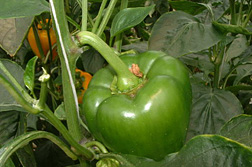This page has been archived and is being provided for reference purposes only. The page is no longer being updated, and therefore, links on the page may be invalid.
| Read the magazine story to find out more. |
|
|
Testing Fumigant Films that Keep the Air Clean
By Dennis O'BrienJuly 26, 2011
U.S. Department of Agriculture (USDA) researchers have found a way to help growers minimize emissions of fumigants used as soil treatments.
Research leader Sharon Papiernik, with the Agricultural Research Service (ARS) North Central Agricultural Research Laboratory in Brookings, S.D., used specially designed chambers to test the permeability of dozens of films used to cover fumigated soil. ARS is USDA's chief intramural scientific research agency, and the research supports the USDA commitment to agricultural sustainability.
Papiernik and her colleagues sandwiched each film between two chambers, injected fumigants into one chamber and measured both the fumigant that passed through the film into the second (receiving) chamber and the fumigant that remained in the source chamber.
The researchers tested 200 film-chemical combinations and came up with a "resistance factor" that could be used to determine emission rates for each film and fumigant under a wide range of growing conditions and weather patterns. Because each fumigant had a different chemistry, each behaved differently with each tarp.
The results, reported in the Journal of Environmental Quality, showed that some films were significantly better barriers to fumigant diffusion than others, but their effectiveness varied, depending on the fumigant tested. Some were less effective under higher humidity levels.
The work is part of a special areawide project to find the best alternatives to methyl bromide, which is being phased out as a fumigant because of its harmful effects on the Earth's protective ozone layer. The work also is intended to help the U.S. Environmental Protection Agency (EPA) and other regulators charged with developing new fumigant requirements to better protect those who use them and neighbors of treated fields.
The EPA is adapting the approach as the standard testing method for evaluating agricultural plastics used in soil fumigation. The results, along with those from other studies, have provided basic standards for film manufacturers and guidance for growers on which films offer the best options for reducing fumigant emissions.
Read more about this research in the July 2011 edition of Agricultural Research magazine.

